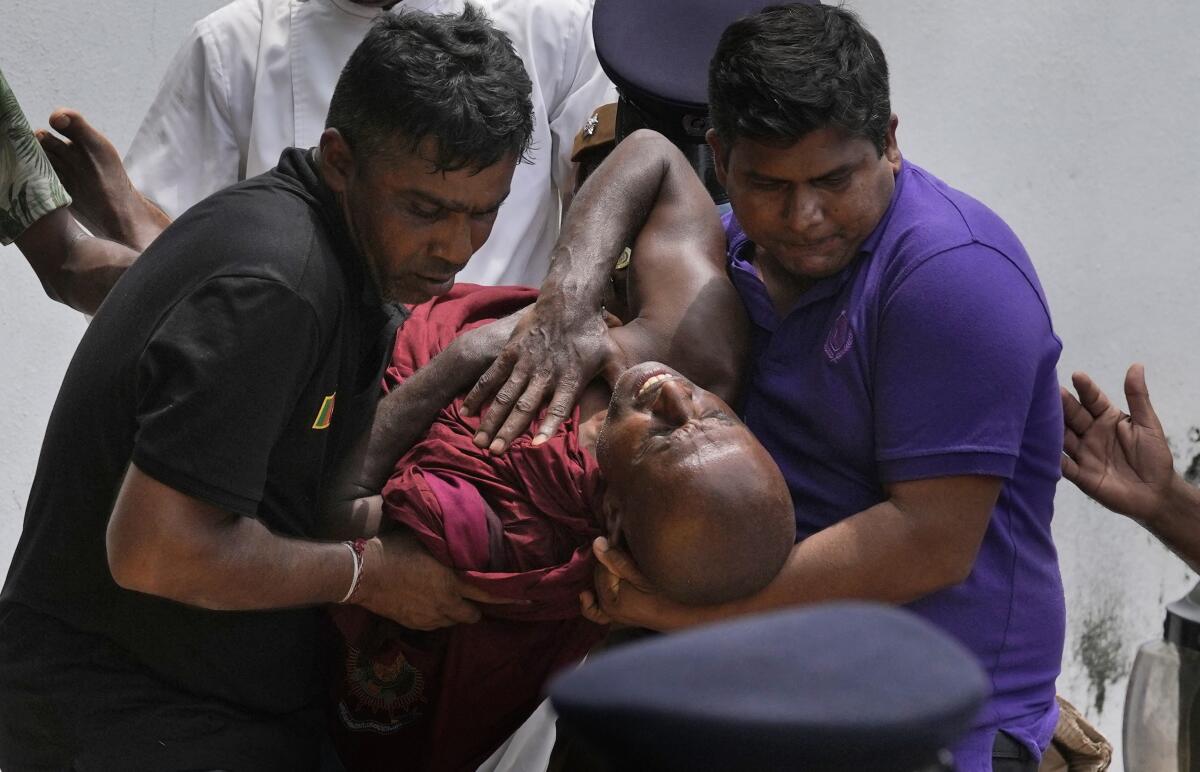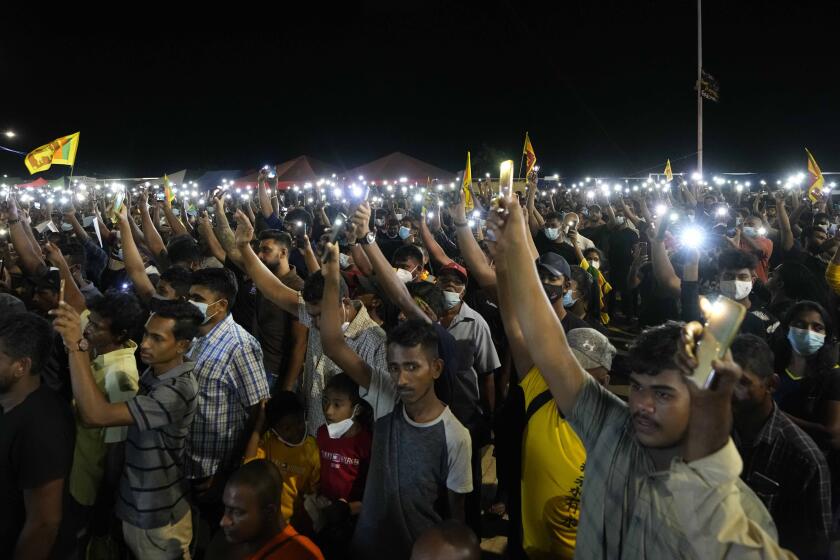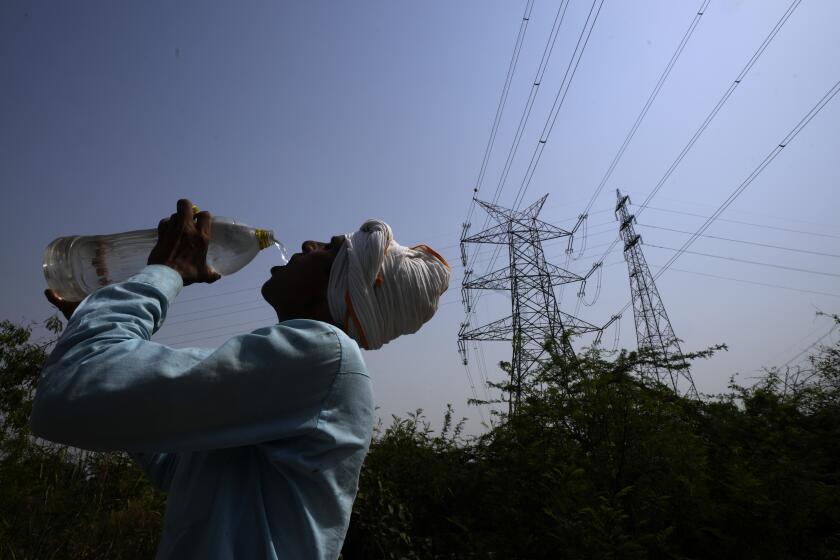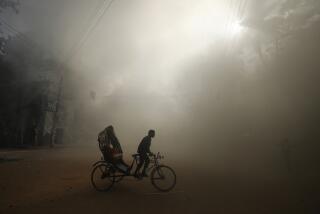Sri Lankan prime minister resigns after weeks of protests

- Share via
COLOMBO, Sri Lanka — Sri Lankan Prime Minister Mahinda Rajapaksa resigned Monday following weeks of protests demanding that he and the president, his brother, step down over the country’s worst economic crisis in decades, an official said.
Rajapaksa said on Twitter that he submitted his resignation to President Gotabaya Rajapaksa. There was no immediate official confirmation from the president’s office.
The resignation comes after authorities deployed armed troops in the capital, Colombo, on Monday following an attack earlier in the day by government supporters on protesters who have been camped outside the offices of the president and prime minister.
The violence triggered widespread anger, with people attacking government supporters in many parts of the country. Homes of some government ministers and politicians supporting the Rajapaksas were attacked and some set on fire.
The island nation off southern India is on the brink of bankruptcy and has suspended payments on its foreign loans. Its economic woes have brought on a political crisis, with the government facing widespread protests and a no-confidence motion in Parliament. Trade unions also called Monday for a general strike until the president and the rest of his ruling family leave.
The president has so far refused to resign, and Parliament must go through a difficult process if it attempts to oust him. The resignation of the prime minister means that the entire Cabinet is dissolved.
Thousands of Sri Lankans take to the streets a day after police opened fire at demonstrators amid the country’s worst economic crisis in decades.
Supporters of the prime minister rallied inside his office earlier Monday, urging him to ignore the protesters’ demand to step down. Rajapaksa told them in a meeting that he was used to protests and revolts and would not run away from challenges.
After the gathering, the Rajapaksa supporters went to the front of the office where protesters have been demonstrating for several days. Television channel Sirasa showed government supporters attacking protesters with clubs and iron bars, demolishing and then burning their tents.
The attack occurred despite a state of emergency declared by the president Friday, which gives him wide powers for riot control.
After demolishing the protest site opposite the prime minister’s residence, the crowd of government supporters proceeded to the entrance to the president’s office. Riot police were deployed with tear gas launchers and several water cannons, but did not use them and let the pro-government demonstrators breach several barriers and march toward the president’s office, where they attacked anti-government protesters and set their camps on fire.
An unusually early and brutal heat wave is scorching parts of India, where acute power shortages are affecting millions as demand for electricity surges to record levels.
Police fired tear gas and a water cannon, but not forcefully enough to disperse the crowd.
After the attack, hundreds of armed soldiers were deployed in Colombo as the protesters accused police of not preventing the assault, despite using tear gas and water cannons on the protesters themselves as recently as Friday.
Sirasa TV showed government lawmaker Sanath Nishantha among the government supporters who attacked the protesters.
At the main hospital in Colombo, 23 people were admitted with non-critical injuries, an official said on condition of anonymity because she was not authorized to speak to the media.
She was a presence at rallies and protests, both interviewing people for the newspaper and at times, taking the megaphone to pump up the crowds.
The attack came as protesters marked their 31st day outside the president’s and prime minister’s offices demanding that they and other powerful Rajapaksa family members quit. Similar protests have spread to other locations, with people setting up camps in other towns across the country.
For several months, Sri Lankans have endured long lines to buy fuel, cooking gas, food and medicine, most of which comes from abroad. Shortages of hard currency have also hindered imports of raw materials for manufacturing and worsened inflation, which surged to 18.7% in March.
Sri Lanka was due to pay $7 billion of its foreign debt this year out of nearly $25 billion it must pay by 2026. Its total foreign debt is $51 billion.
Sri Lanka’s finance minister announced earlier this week that the country’s usable foreign reserves have plummeted below $50 million.
Breaking News
Get breaking news, investigations, analysis and more signature journalism from the Los Angeles Times in your inbox.
You may occasionally receive promotional content from the Los Angeles Times.
As oil prices soar during the Russia-Ukraine conflict, Sri Lanka’s fuel stocks are running out. Authorities have announced that nationwide power cuts will increase to about four a day because they can’t supply enough fuel to power-generating stations.
Protesters have crowded the streets since March, maintaining that President Rajapaksa and his family — who have dominated nearly every aspect of life in Sri Lanka for most of the last 20 years — are responsible for the crisis.
Sri Lanka has been holding talks with the International Monetary Fund to get an immediate funding facility as well as a long-term rescue plan but was told that its progress would depend on negotiations on debt restructuring with creditors.
Any long-term plan would take at least six months to get underway.
More to Read
Sign up for Essential California
The most important California stories and recommendations in your inbox every morning.
You may occasionally receive promotional content from the Los Angeles Times.















